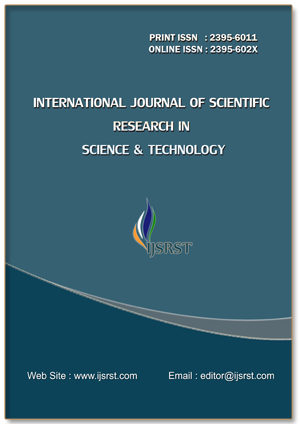Area Efficient BCD Seven Segment Circuit Designing Using QCA
Keywords:
Quantum-dot Cellular Automata (QCA), seven segment display, Arithmetic Logic Unit (ALU), Multiplexer, Full adder.Abstract
Quantum-dot Cellular Automata (QCA) is a new Nano-scale technology that due to making significant improvements in the design of electronic circuits can be considered as an appropriate alternative to CMOS technology. It is an alternative nanotechnology which keeps scaling down the technology further. It can do scaling beyond to a level where complementary metal oxide semiconductor (CMOS) scaling rises the issue. QCA is seen as an emerging solution for Nano-architectures. In our work, Seven Segment Display is proposed using different gates and majority voter gate in QCA which is having less area and high performance. This nanotechnology uses different logic devices for digital circuit designing for obtaining a high rate of performance at output. This new nanotechnology uses a specific method to represent and decode the data. The main aim behind our work is to understand the basic QCA technology and to get familiar with the QCA designer software for getting involved in advanced designing of digital circuits using QCA. A seven Segment Display uses Light Emitting Diodes to display output that can be in the form of image, text or decimal number. The simulation results verify that our work is significant.
References
- C. S. Lent, P. D. Tougaw, W. Porod and G. H. Bernstein, "Quantum cellular automata", Nanotechnology, vol. 4, no. 1 pp. 49, 1993.
- A. M. Chabi, A. Roohi, H. Khademolhosseini, S. Sheikhfaal, S. Angizi, K. Navi and R. F. DeMara, "Towards ultra-efficient QCA reversible circuits", Microprocessors and Microsystems, vol. 49. pp. 127-138, 2017.
- M. Mohammadi, M. Mohammadi and S. Gorgin, "An efficient design of full adder in quantum-dot cellular automata (QCA) technology", Microelectronics Journal, vol. 50, pp. 35-43, 2016.
- C. Heller, E. Heidinger, S. Schneele, W. Fischer and P. Klose, "Power-over-Ethernet for avionic networks", In 29th Digital Avionics Systems Conference, pp. 5-A. IEEE, 2010.
- V. K. Sharma, "Optimal design for digital comparator using QCA nanotechnology with energy estimation", International Journal of Numerical Modelling: Electronic Networks, Devices and Fields, In press, 2020.
- J. F. Chaves, M. A. Ribeiro, L. M. Silva, L. MBC de Assis, M. S. Torres and O. P. V. Neto, "Energy efficient QCA circuits design: simulating and analyzing partially reversible pipelines", Journal of Computational Electronics, vol. 17, no. 1, pp. 479-489, 2018.
- H. R. Roshany and A. Rezai, "Novel efficient circuit design for multilayer QCA RCA", International Journal of Theoretical Physics, vol. 58, no. 6, pp. 1745-1757, 2019.
- S. Riyaz, S. F. Naz and V. K. Sharma, "Multioperative reversible gate design with implementation of 1̺bit full adder and subtractor along with energy dissipation analysis", International Journal of Circuit Theory and Applications, In-press, 2020.
- A. T. Vanaraj, M. Raj and L. Gopalakrishnan, "Energy-Efficient Coplanar Adder and Subtractor in QCA", In 2020 Third International Conference on Smart Systems and Inventive Technology (ICSSIT), pp. 539-544. IEEE, 2020.
- M. Liu and C. S. Lent, "Bennett and Landauer clocking in quantum dot cellular automata", In 10th International Workshop on Computational Electronics, pp. 120-121, 2004.
- R. K. Nath, B. Sen and B. K. Sikdar, "Optimal synthesis of QCA logic circuit eliminating wire-crossings", IET Circuits, Devices & Systems, vol. 11, no. 3, pp. 201-208, 2017.
- M. Balali and A. Rezai, "Design of low-complexity and high-speed coplanar four-bit ripple carry adder in QCA technology", International Journal of Theoretical Physics, vol. 57, no. 7, pp. 1948- 1960, 2018.
- A. Norouzi and S. R. Heikalabad, “Design of reversible parity generator and checker for the implementation of nano-communication systems in quantum-dot cellular automata,” Photonic Network Communications, vol. 38, no. 2, pp. 231–243, 2019.
- J. C. Das and D. De, “Quantum-dot cellular automata based reversible low power parity generator and parity checker design for nanocommunication,” Frontiers of Information Technology & Electronic Engineering, vol. 17, no. 3, pp. 224–236, 2016.
- S. Sheikhfaal, S. Angizi, S. Sarmadi, M. Hossein Moaiyeri, and S. Sayedsalehi, “Designing efficient QCA logical circuits with power dissipation analysis,” Microelectronics Journal, vol. 46, no. 6, pp. 462–471, 2015.
Downloads
Published
Issue
Section
License
Copyright (c) IJSRST

This work is licensed under a Creative Commons Attribution 4.0 International License.

